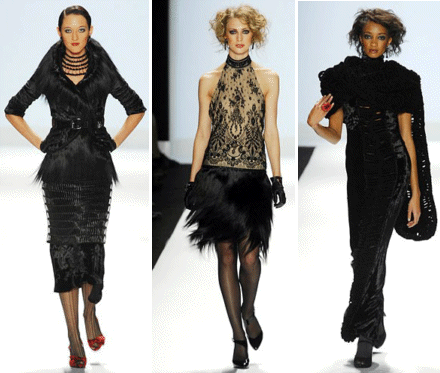The Mad Genius of Chris March

Our friend, Chris March passed away in September 2019 after a prolonged illness from a debilitating fall. We miss his larger-than-life personality and his cartoon laugh. Here is an interview that we did with Chris several years ago....
It’s been a few years since fashion designer Chris March appeared on Season 4 of Project Runway but he still can’t walk down a street in New York without someone stopping him. With his appearance on the TV reality show, his own Bravo show Mad Fashion, and his recent partnership with Target, he's gained exposure, fame, and jobs. But he’s still plugging away at fashion design and he’s game for all kinds of off-beat projects. We’re happy to have Chris to interview for our blog.

Wear your vegetables: Dress made of lettuce
Escama: Do you consider yourself primarily a fashion designer of apparel? In your career what do you aspire to be?
CM: I consider myself a costume and fashion designer. I first started out making costumes; I designed crazy gigantic hats for the stage production, Beach Blanket Babylon that has been running forever in San Francisco. It was a lot of fun and I did it for years but I had to come to New York.
Escama: How did you get into Project Runway?
CM: I was doing a promotion for Wishbone Salad Dressing in Grand Central Station. There was a catwalk with models dressed in outfits that I had designed in vegetables, skirts made out of lettuce. It was a new product launch – Wishbone salad dressing in a spray form. The emcee of the show was Tim Gunn of Project Runway and he came up to me afterwards and said that I should try out. That I HAD to try out (!)
Escama: I heard that your grand finale on Project Runway was a collection of dresses made of human hair.
CM: Yes, that was the final project. A lot of the things that I do are lighthearted and fun. But my sensibility is much darker than most of the projects that I’m known for. The collection made with human hair definitely stopped people in their tracks but it wasn’t gratuitous. I liked a lot of the qualities and texture of that medium.

Project Runway final 3: crocheted dresses made with human hair
Escama: You had a great run of successes after Project Runway, you designed Meryl Streep’s dress for the Golden Globes and the Oscars in 2010. That must have been immensely satisfying, right?
CM: It was frankly pretty surreal. I got to go to Meryl’s apartment for a fitting (yes, I call her Meryl). Then I went back to my hovel in Hell’s Kitchen and made the dresses at my kitchen table. Hahahaha! Yes, it was very satisfying. It was (and will always be) a high point.

The Devil Wears Chris March
Escama: With this recognition do you think that you might consider designing for a fashion house?
CM: Well, never say never. But frankly, in the current world of fashion it’s hard to be creative and successful as a designer at a fashion house. The fate of fashion school graduates -- recent graduates who are fresh out of design school – is working long hours for not much money. It’s commerce rather than art. It might even be easier to support yourself as a costume designer rather than a fashion designer.
Escama: Is 'Fast Fashion' dead? What is your take on trends like ‘fast fashion’ and ‘sustainable fashion’?
Chris: Well when the economy is lousy and a lot of people are hard up for cash, there’s obviously some appeal to an H&M trench coat that is advertised for $15.00. $15.00!!! It looks great but how many times can you wear it out in the rain before it melts? ‘Fast fashion’ is going to be the clothing equivalent of IKEA: it’ll be the training wheels that everybody starts out on. But if more money comes into your pocket you’ll want an upgrade. People buy into a lot of tried and true brands because it’s aspirational – they want the association with all the prestige that comes with the brand. I tend to think of ‘sustainable fashion’ in a couple of ways – sustainable in the sense that it’s built to last. And secondly sustainable because thought has gone into the way the apparel was manufactured; by whom and with what ingredients. If high end designers care enough to create things sustainably then the people who aspire to owning these high end designs will follow. Hard to say who is in the lead and who is following; is it the designers giving the people what they demand or are the people catching up to the designers’ direction to sustainability...
For more articles on fashion designers, we invite you to read our article on 1960s iconic fashion designer Paco Rabanne. If you're interested in 'trash fashion' then head over to read about trash fashion designer Sara Basehart. Also read about trailblazing handbag designers making sustainable handbags from up-cycled material.


Leave a comment